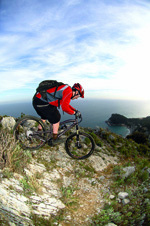 FRAME
FRAME
The medium frame measures 17.25in from the centre of the bottom bracket to the top of the seat collar, so it is small for a medium. Granted the Nomad doesn’t have the shortest wheelbase or top tube on test, but with a 25in down tube it has the shortest cockpit. For that reason you may want a large frame if you are 5’11 or taller. It’s roughly 3/4in longer and the additional length in the top tube means that you don’t need to worry about catching your knees on the stem. Even with a large frame you still benefit from the incredibly low 28.5in standover height, as the monocoque top tube drops to the same position on all frame sizes so that the upper link of the VPP suspension is in the same place to maintain the suspension characteristics.
The short links of the VPP design put huge loads through the pivot bearings and Santa Cruz has improved bearing quality for ’07. By slimming down the bearing races its has been able to increase the size of the balls without having to redesign the frame and links. The new bearings also have double seals, are retro-fitable to earlier Nomads and come with a lifetime warranty. Frames with 1.5in head tubes will be here in May and the change will become standard on all Nomads.
SUSPENSION
In comparison to the Intense the Fox DHX 5.0 shock on the Nomad is surprisingly easy to set-up. The suspension is much less sensitive to sag allowing the rear suspension to be run easily with anything from 20 to 40 per cent sag. So for anyone trying to cover a wide variety of riding situations with one bike you can easily tailor the head angle and bottom bracket to match the preferred riding style. Obviously this compromises available travel, but don’t fret about it — inch count isn’t as important as handling. The longer stroke shock on the Nomad gives a lower average leverage ratio than the Intense, and as a result the Nomad runs lower shock pressures. The only drawback that we found with running the shock with lots of sag for descending is that you have to get used to the back end sitting up (shock extending) under braking. The Nomad’s tendency for brake jack is unsettling at first but it is easy enough to ride around and adding a few extra clicks of rebound damping helps a lot.
PERFORMANCE
Heading out toward the trail head we were quickly reminded why the last Nomad we tested saw so much action in the short space of time that we had it. It is so much fun to ride and seems to carry speed amazingly well. Suspension feedback into the drivetrain is noticeable when climbing, but it is much less pronounced than on the Intense. For descending we suggest sticking it in the big ring (if you have one), as your feet will be fighting less with the suspension forces. At 66.7 degrees the Nomad has the slackest head angle on test and it’s the only bike here that we’d consider fitting an adjustable travel fork to, allowing us to improve the geometry for climbing. Hit the descents, though, and the angles are spot on for ripping. It’s also the plushest bike tested, so suspension performance mates perfectly with the geometry. We enjoyed riding the Nomad so much we extended our test loop, climbing higher and descending for longer, and at the bottom of our run we felt the freshest of the three bikes tested, even though the opposite should have been true as the Nomad was the last bike out.
VERDICT
Lots of bikes get branded with the do-it-all tag but the Nomad is one of the few rides worthy
of the title. At 30.5lb, with the only nod to weight-saving being the Avid Juicy Ultimate brakes, the Nomad is light enough for regular trail riding and strong enough to hammer most DH tracks. In a word — versatile.
MBR RATING 9/10



